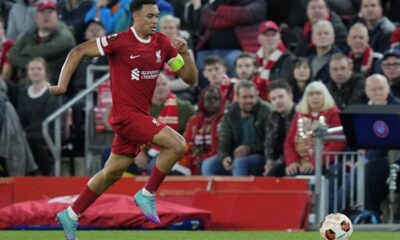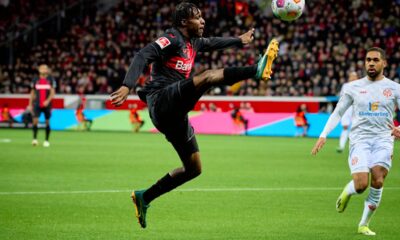Football
El derbi Madrileño, or the duel between Real Madrid and Atlético Madrid. Where did the rivalry originate?
When you say rivalry in Spain, everyone immediately thinks of Real Madrid and Barcelona. But very heated is also “El Derbi Madrileño,” i.e. the duel between Real Madrid and Atlético Madrid. Where did this rivalry originate?
When you say rivalry in Spain, everyone immediately thinks of Real Madrid and Barcelona. But very heated is also “El Derbi Madrileño,” i.e. the duel between Real Madrid and Atlético Madrid. Where did this rivalry originate?
Real Madrid and Atlético Madrid have a huge rivalry. It’s the second biggest derby in Spain, but for Atlético fans, the duel with the hated Real is the greatest thing that can happen in football.
There is a reason for that. The Colchoneros see Real as the richer, better, more successful, pretentious neighbour for whom they wish only the worst. That’s why it’s often said that Atlético fans’ hatred of Real is much greater than the other way around. For a long time, Atleti were more of a ‘pain in the arse’ for Real than an equal opponent, but after the arrival of Diego Simeone, the rivalry has once again risen to the highest possible level.
The emergence of the rivalry
The rivalry between the two clubs was born right from the beginning of the twentieth century. Real Madrid (then called Madrid FC) was the strongest club in the Spanish capital. It gradually picked up the best players from all the other clubs in the city, due to which no one was able to compete with Madrid.
The only exception was Athletic Club Madrid . It was able to keep its best players thanks to financial help from its friendly club Athletic Club Bilbao, which was like a father to Atlético. After him, Atlético took its name and became Madrid FC’s only competitor in the city.
Madrid was granted the status of “Real,” which means royal club in 1920 and is granted by the King of Spain to his favourite clubs. This angered Atlético fans, who saw Real as a favored club. It even angered a few Los Blancos fans, who switched to the Rojiblancos and the rivalry became even more heated.
On the pitch, however, Real Madrid had no competition. It clearly had the upper hand over Atlético Madrid, but only until the Spanish Civil War.
After the war, before the reign of General Franco, Atlético allied itself with the military air force. During this period, the Colchoneros became the most successful club in Spain, reducing the trophy gap between them and Real, only for the 1950s and General Franco to arrive.
It’s no secret that the single-minded dictator sided with Real Madrid. Under his leadership, the royal club regained the Spanish football throne, Franco even banned the use of Catalan, and so the hatred with Barcelona escalated during this period as well.
“El equipo del gobierno, la vergüenza del país,” translated, “The team of the government, the shame of the nation.“
Social differences
In the 1970s, however, Atlético began to dominate Spanish football again, and Real fans couldn’t help calling Atlético “Indios” (Indians, because of the large number of South American players in Atlético’s squad).
At that time, Real Madrid signed only Caucasian players. President Santiago Bernabéu even once explained the non-signing of the Portuguese Eusébio as follows Atlético, however, is not bothered by the Indios nickname and still uses it today.
This ties in with another difference and reason for the rivalry between the two clubs. Real Madrid is a classy, white, sacred club, which in Spain is more likely to be opposed by the upper class and wealthier people. Atlético, on the other hand, is more of a working-class club, with a fan base from the south of the city and from poorer backgrounds. The atmosphere in the stadiums corresponds to this. While Atlético’s cauldron can create hell, Santiago Bernabéu is more famous for waving a white handkerchief.
A modern-day joust
Czech Radek Bejbl played for Atlético Madrid from 1996-2000 and Tomas Ujfalusi defended the colours of the red and white club from 2008-2011. No Czech has played for Real Madrid.
The most famous clash between the two teams is the 2014 Champions League final in Lisbon. It was the first time in the history of this competition that two teams from the same city faced each other in the final. Atlético took the lead, only for Sergio Ramos to head in a corner at 92:48 to send the game into extra time. There, Real Atlético destroyed Atlético and won their tenth Champions League title thanks to goals from Bale, Marcelo and Ronaldo.
But the rivalry continued, with Diego Simeone on the Atlético bench, the games were heated. So in 2016, there was a replay when Real and Atlético met again in the Champions League final, this time in Milan. Once again Real won, this time on penalties, the winning one converted by Cristiano Ronaldo.
These two finals will forever be remembered by Real Madrid Colchoneros fans. Los Blancos fans have even created a new chant for this special occasion:
Los años van pasando,
Y todo sigue igual
Perdiendo las finales,
Contra nuestro Real
No importa lo que digan
Nunca lo olvidaran
Lloraron en Lisboa,
Lloraron en Milan.
Years pass, and everything remains the same. They lose the final, against our Real. It doesn’t matter what they say, they’ll never forget it. They cried in Lisbon, they cried in Milan.”
Two years later, the two teams faced off in the UEFA Super Cup, which Atlético won, at least somewhat making up for their poor record against Real.
The overall statistics are clearly in favour of Los Blancos. The two teams have played 227 matches to date, Real Madrid have dominated 112 matches, Atlético have won 56 times and there have been 59 draws.
Source: Wikipedia, Real Madrid, Atlético Madrid












